ACC00712 Essay: Revaluation of Assets, Accounting Standards, and DBF
VerifiedAdded on 2022/11/26
|9
|2730
|459
Essay
AI Summary
This essay provides a comprehensive analysis of asset revaluation within the context of business accounting, focusing on the principles and practices in Australian financial reporting. It begins by examining the concept of asset revaluation, highlighting its significance in reflecting the true value of capital assets and its distinction from depreciation. The essay then delves into the purpose of revaluation, emphasizing its role in providing a faithful representation of fixed assets, supporting informed business decisions, and facilitating accurate financial reporting. It discusses the application of Australian Accounting Standards Board (AASB) standards, particularly AASB 101, and their alignment with International Financial Reporting Standards (IFRSs). The essay further explores the fundamental qualitative characteristics of accounting information, including relevance and faithful representation, and the enhancing characteristics such as verifiability, timeliness, understandability, and comparability. It then analyzes the specific accounting practices of DBF, focusing on its adherence to AASB and IFRS, the valuation of assets, and the impact of revaluation on financial statements. The essay also examines the reaction of investors to the disclosure of accounting information, including critical accounting judgements and uncertainties, as well as the importance of effective communication and logical presentation in financial reports.
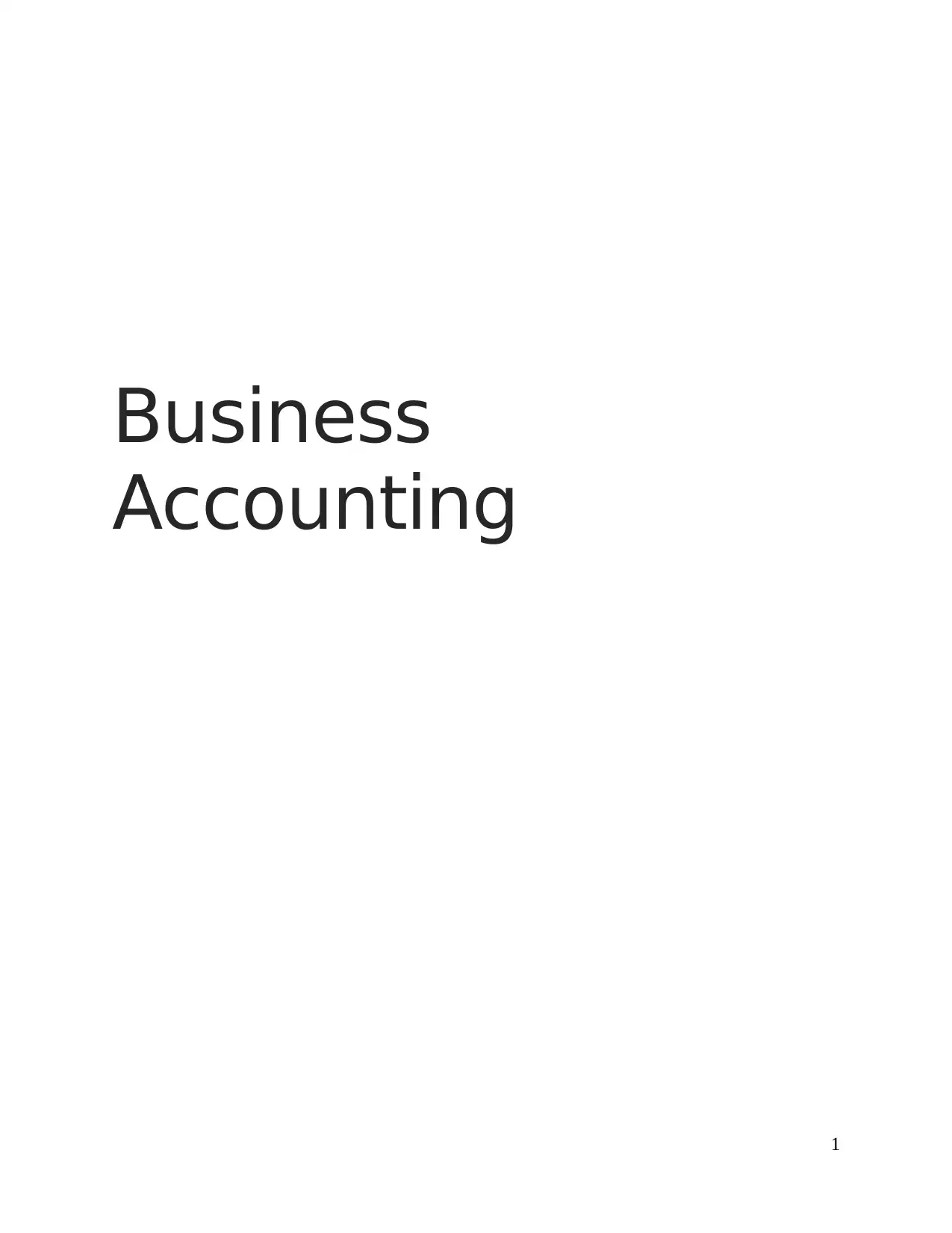
Business
Accounting
1
Accounting
1
Paraphrase This Document
Need a fresh take? Get an instant paraphrase of this document with our AI Paraphraser
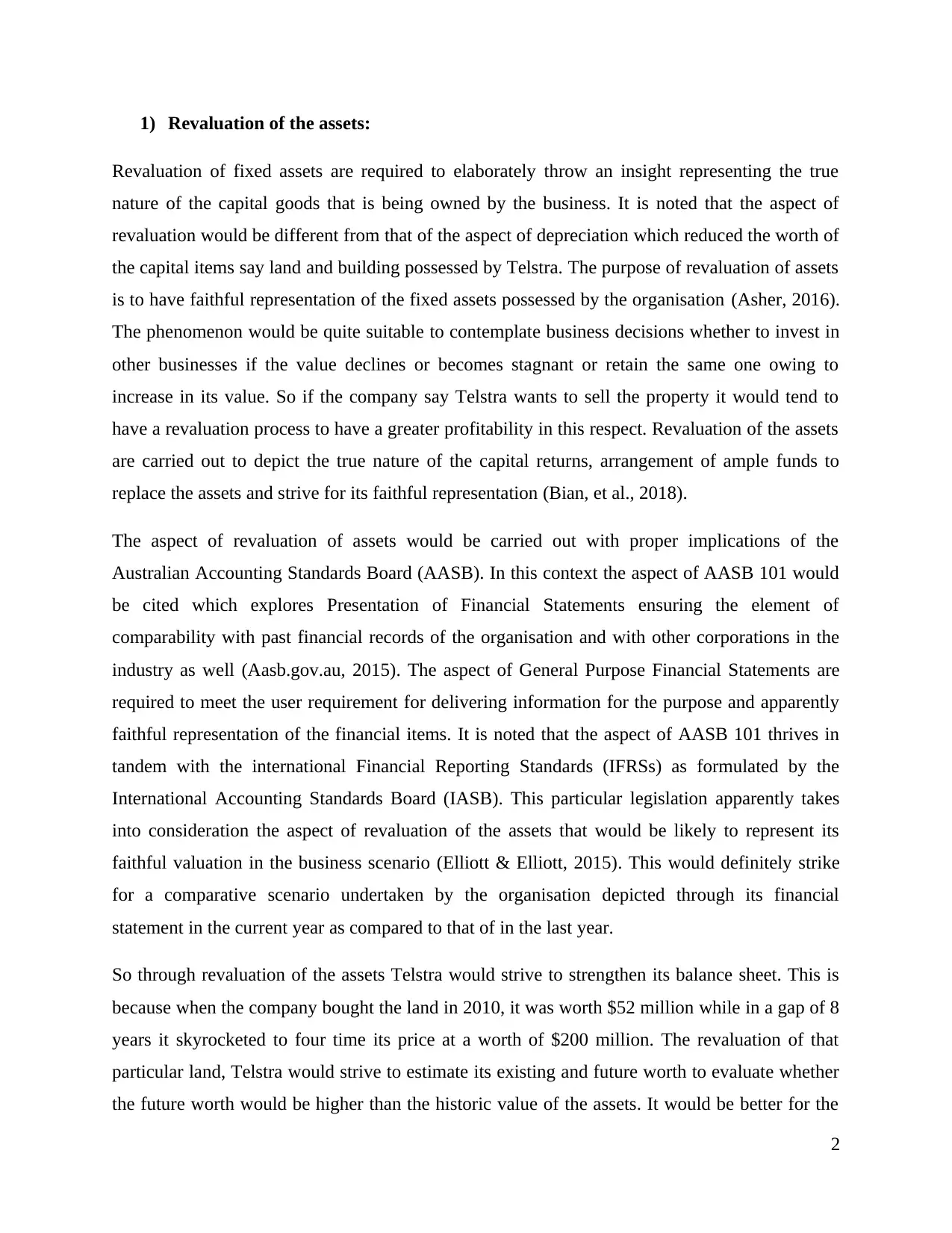
1) Revaluation of the assets:
Revaluation of fixed assets are required to elaborately throw an insight representing the true
nature of the capital goods that is being owned by the business. It is noted that the aspect of
revaluation would be different from that of the aspect of depreciation which reduced the worth of
the capital items say land and building possessed by Telstra. The purpose of revaluation of assets
is to have faithful representation of the fixed assets possessed by the organisation (Asher, 2016).
The phenomenon would be quite suitable to contemplate business decisions whether to invest in
other businesses if the value declines or becomes stagnant or retain the same one owing to
increase in its value. So if the company say Telstra wants to sell the property it would tend to
have a revaluation process to have a greater profitability in this respect. Revaluation of the assets
are carried out to depict the true nature of the capital returns, arrangement of ample funds to
replace the assets and strive for its faithful representation (Bian, et al., 2018).
The aspect of revaluation of assets would be carried out with proper implications of the
Australian Accounting Standards Board (AASB). In this context the aspect of AASB 101 would
be cited which explores Presentation of Financial Statements ensuring the element of
comparability with past financial records of the organisation and with other corporations in the
industry as well (Aasb.gov.au, 2015). The aspect of General Purpose Financial Statements are
required to meet the user requirement for delivering information for the purpose and apparently
faithful representation of the financial items. It is noted that the aspect of AASB 101 thrives in
tandem with the international Financial Reporting Standards (IFRSs) as formulated by the
International Accounting Standards Board (IASB). This particular legislation apparently takes
into consideration the aspect of revaluation of the assets that would be likely to represent its
faithful valuation in the business scenario (Elliott & Elliott, 2015). This would definitely strike
for a comparative scenario undertaken by the organisation depicted through its financial
statement in the current year as compared to that of in the last year.
So through revaluation of the assets Telstra would strive to strengthen its balance sheet. This is
because when the company bought the land in 2010, it was worth $52 million while in a gap of 8
years it skyrocketed to four time its price at a worth of $200 million. The revaluation of that
particular land, Telstra would strive to estimate its existing and future worth to evaluate whether
the future worth would be higher than the historic value of the assets. It would be better for the
2
Revaluation of fixed assets are required to elaborately throw an insight representing the true
nature of the capital goods that is being owned by the business. It is noted that the aspect of
revaluation would be different from that of the aspect of depreciation which reduced the worth of
the capital items say land and building possessed by Telstra. The purpose of revaluation of assets
is to have faithful representation of the fixed assets possessed by the organisation (Asher, 2016).
The phenomenon would be quite suitable to contemplate business decisions whether to invest in
other businesses if the value declines or becomes stagnant or retain the same one owing to
increase in its value. So if the company say Telstra wants to sell the property it would tend to
have a revaluation process to have a greater profitability in this respect. Revaluation of the assets
are carried out to depict the true nature of the capital returns, arrangement of ample funds to
replace the assets and strive for its faithful representation (Bian, et al., 2018).
The aspect of revaluation of assets would be carried out with proper implications of the
Australian Accounting Standards Board (AASB). In this context the aspect of AASB 101 would
be cited which explores Presentation of Financial Statements ensuring the element of
comparability with past financial records of the organisation and with other corporations in the
industry as well (Aasb.gov.au, 2015). The aspect of General Purpose Financial Statements are
required to meet the user requirement for delivering information for the purpose and apparently
faithful representation of the financial items. It is noted that the aspect of AASB 101 thrives in
tandem with the international Financial Reporting Standards (IFRSs) as formulated by the
International Accounting Standards Board (IASB). This particular legislation apparently takes
into consideration the aspect of revaluation of the assets that would be likely to represent its
faithful valuation in the business scenario (Elliott & Elliott, 2015). This would definitely strike
for a comparative scenario undertaken by the organisation depicted through its financial
statement in the current year as compared to that of in the last year.
So through revaluation of the assets Telstra would strive to strengthen its balance sheet. This is
because when the company bought the land in 2010, it was worth $52 million while in a gap of 8
years it skyrocketed to four time its price at a worth of $200 million. The revaluation of that
particular land, Telstra would strive to estimate its existing and future worth to evaluate whether
the future worth would be higher than the historic value of the assets. It would be better for the
2
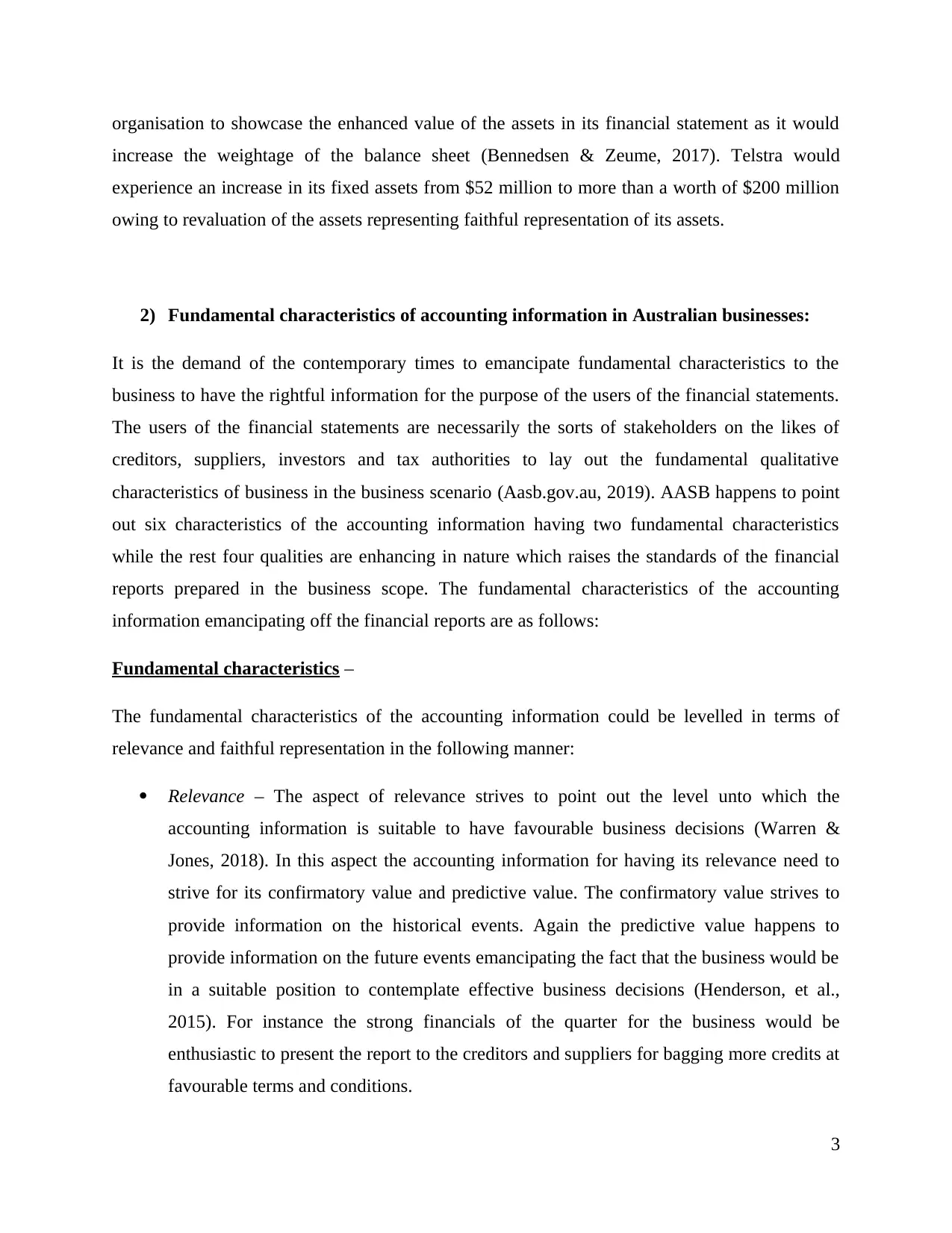
organisation to showcase the enhanced value of the assets in its financial statement as it would
increase the weightage of the balance sheet (Bennedsen & Zeume, 2017). Telstra would
experience an increase in its fixed assets from $52 million to more than a worth of $200 million
owing to revaluation of the assets representing faithful representation of its assets.
2) Fundamental characteristics of accounting information in Australian businesses:
It is the demand of the contemporary times to emancipate fundamental characteristics to the
business to have the rightful information for the purpose of the users of the financial statements.
The users of the financial statements are necessarily the sorts of stakeholders on the likes of
creditors, suppliers, investors and tax authorities to lay out the fundamental qualitative
characteristics of business in the business scenario (Aasb.gov.au, 2019). AASB happens to point
out six characteristics of the accounting information having two fundamental characteristics
while the rest four qualities are enhancing in nature which raises the standards of the financial
reports prepared in the business scope. The fundamental characteristics of the accounting
information emancipating off the financial reports are as follows:
Fundamental characteristics –
The fundamental characteristics of the accounting information could be levelled in terms of
relevance and faithful representation in the following manner:
Relevance – The aspect of relevance strives to point out the level unto which the
accounting information is suitable to have favourable business decisions (Warren &
Jones, 2018). In this aspect the accounting information for having its relevance need to
strive for its confirmatory value and predictive value. The confirmatory value strives to
provide information on the historical events. Again the predictive value happens to
provide information on the future events emancipating the fact that the business would be
in a suitable position to contemplate effective business decisions (Henderson, et al.,
2015). For instance the strong financials of the quarter for the business would be
enthusiastic to present the report to the creditors and suppliers for bagging more credits at
favourable terms and conditions.
3
increase the weightage of the balance sheet (Bennedsen & Zeume, 2017). Telstra would
experience an increase in its fixed assets from $52 million to more than a worth of $200 million
owing to revaluation of the assets representing faithful representation of its assets.
2) Fundamental characteristics of accounting information in Australian businesses:
It is the demand of the contemporary times to emancipate fundamental characteristics to the
business to have the rightful information for the purpose of the users of the financial statements.
The users of the financial statements are necessarily the sorts of stakeholders on the likes of
creditors, suppliers, investors and tax authorities to lay out the fundamental qualitative
characteristics of business in the business scenario (Aasb.gov.au, 2019). AASB happens to point
out six characteristics of the accounting information having two fundamental characteristics
while the rest four qualities are enhancing in nature which raises the standards of the financial
reports prepared in the business scope. The fundamental characteristics of the accounting
information emancipating off the financial reports are as follows:
Fundamental characteristics –
The fundamental characteristics of the accounting information could be levelled in terms of
relevance and faithful representation in the following manner:
Relevance – The aspect of relevance strives to point out the level unto which the
accounting information is suitable to have favourable business decisions (Warren &
Jones, 2018). In this aspect the accounting information for having its relevance need to
strive for its confirmatory value and predictive value. The confirmatory value strives to
provide information on the historical events. Again the predictive value happens to
provide information on the future events emancipating the fact that the business would be
in a suitable position to contemplate effective business decisions (Henderson, et al.,
2015). For instance the strong financials of the quarter for the business would be
enthusiastic to present the report to the creditors and suppliers for bagging more credits at
favourable terms and conditions.
3
⊘ This is a preview!⊘
Do you want full access?
Subscribe today to unlock all pages.

Trusted by 1+ million students worldwide
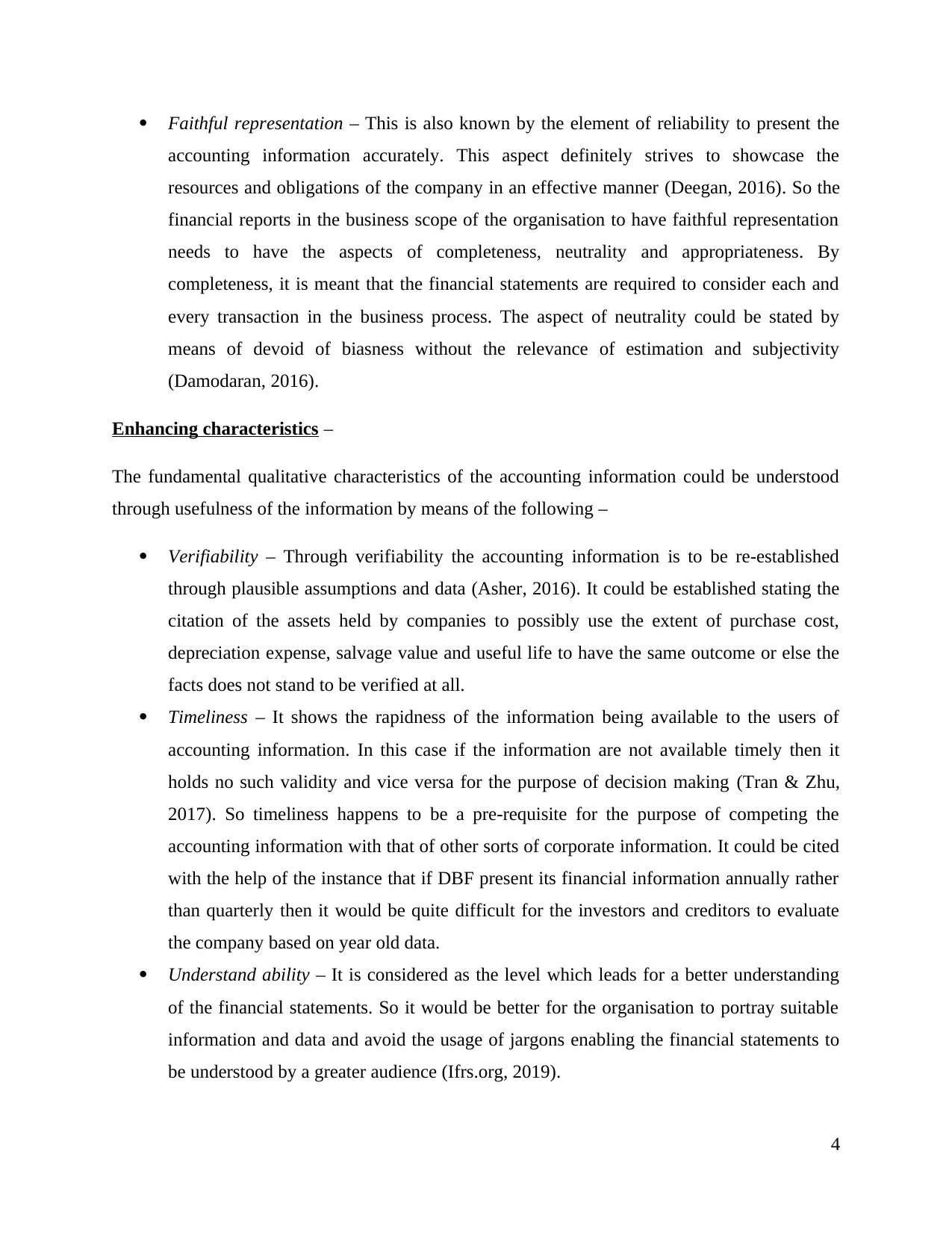
Faithful representation – This is also known by the element of reliability to present the
accounting information accurately. This aspect definitely strives to showcase the
resources and obligations of the company in an effective manner (Deegan, 2016). So the
financial reports in the business scope of the organisation to have faithful representation
needs to have the aspects of completeness, neutrality and appropriateness. By
completeness, it is meant that the financial statements are required to consider each and
every transaction in the business process. The aspect of neutrality could be stated by
means of devoid of biasness without the relevance of estimation and subjectivity
(Damodaran, 2016).
Enhancing characteristics –
The fundamental qualitative characteristics of the accounting information could be understood
through usefulness of the information by means of the following –
Verifiability – Through verifiability the accounting information is to be re-established
through plausible assumptions and data (Asher, 2016). It could be established stating the
citation of the assets held by companies to possibly use the extent of purchase cost,
depreciation expense, salvage value and useful life to have the same outcome or else the
facts does not stand to be verified at all.
Timeliness – It shows the rapidness of the information being available to the users of
accounting information. In this case if the information are not available timely then it
holds no such validity and vice versa for the purpose of decision making (Tran & Zhu,
2017). So timeliness happens to be a pre-requisite for the purpose of competing the
accounting information with that of other sorts of corporate information. It could be cited
with the help of the instance that if DBF present its financial information annually rather
than quarterly then it would be quite difficult for the investors and creditors to evaluate
the company based on year old data.
Understand ability – It is considered as the level which leads for a better understanding
of the financial statements. So it would be better for the organisation to portray suitable
information and data and avoid the usage of jargons enabling the financial statements to
be understood by a greater audience (Ifrs.org, 2019).
4
accounting information accurately. This aspect definitely strives to showcase the
resources and obligations of the company in an effective manner (Deegan, 2016). So the
financial reports in the business scope of the organisation to have faithful representation
needs to have the aspects of completeness, neutrality and appropriateness. By
completeness, it is meant that the financial statements are required to consider each and
every transaction in the business process. The aspect of neutrality could be stated by
means of devoid of biasness without the relevance of estimation and subjectivity
(Damodaran, 2016).
Enhancing characteristics –
The fundamental qualitative characteristics of the accounting information could be understood
through usefulness of the information by means of the following –
Verifiability – Through verifiability the accounting information is to be re-established
through plausible assumptions and data (Asher, 2016). It could be established stating the
citation of the assets held by companies to possibly use the extent of purchase cost,
depreciation expense, salvage value and useful life to have the same outcome or else the
facts does not stand to be verified at all.
Timeliness – It shows the rapidness of the information being available to the users of
accounting information. In this case if the information are not available timely then it
holds no such validity and vice versa for the purpose of decision making (Tran & Zhu,
2017). So timeliness happens to be a pre-requisite for the purpose of competing the
accounting information with that of other sorts of corporate information. It could be cited
with the help of the instance that if DBF present its financial information annually rather
than quarterly then it would be quite difficult for the investors and creditors to evaluate
the company based on year old data.
Understand ability – It is considered as the level which leads for a better understanding
of the financial statements. So it would be better for the organisation to portray suitable
information and data and avoid the usage of jargons enabling the financial statements to
be understood by a greater audience (Ifrs.org, 2019).
4
Paraphrase This Document
Need a fresh take? Get an instant paraphrase of this document with our AI Paraphraser
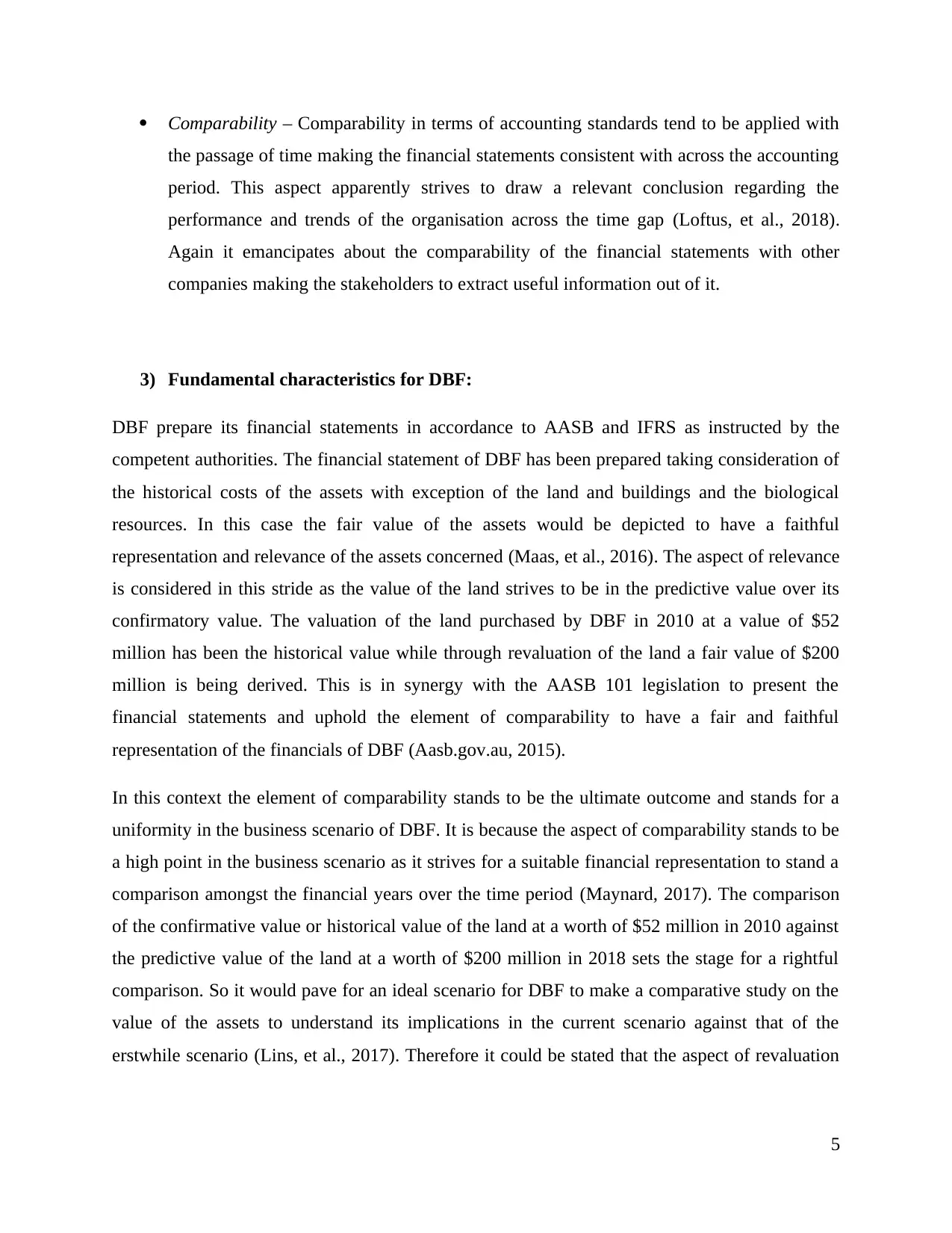
Comparability – Comparability in terms of accounting standards tend to be applied with
the passage of time making the financial statements consistent with across the accounting
period. This aspect apparently strives to draw a relevant conclusion regarding the
performance and trends of the organisation across the time gap (Loftus, et al., 2018).
Again it emancipates about the comparability of the financial statements with other
companies making the stakeholders to extract useful information out of it.
3) Fundamental characteristics for DBF:
DBF prepare its financial statements in accordance to AASB and IFRS as instructed by the
competent authorities. The financial statement of DBF has been prepared taking consideration of
the historical costs of the assets with exception of the land and buildings and the biological
resources. In this case the fair value of the assets would be depicted to have a faithful
representation and relevance of the assets concerned (Maas, et al., 2016). The aspect of relevance
is considered in this stride as the value of the land strives to be in the predictive value over its
confirmatory value. The valuation of the land purchased by DBF in 2010 at a value of $52
million has been the historical value while through revaluation of the land a fair value of $200
million is being derived. This is in synergy with the AASB 101 legislation to present the
financial statements and uphold the element of comparability to have a fair and faithful
representation of the financials of DBF (Aasb.gov.au, 2015).
In this context the element of comparability stands to be the ultimate outcome and stands for a
uniformity in the business scenario of DBF. It is because the aspect of comparability stands to be
a high point in the business scenario as it strives for a suitable financial representation to stand a
comparison amongst the financial years over the time period (Maynard, 2017). The comparison
of the confirmative value or historical value of the land at a worth of $52 million in 2010 against
the predictive value of the land at a worth of $200 million in 2018 sets the stage for a rightful
comparison. So it would pave for an ideal scenario for DBF to make a comparative study on the
value of the assets to understand its implications in the current scenario against that of the
erstwhile scenario (Lins, et al., 2017). Therefore it could be stated that the aspect of revaluation
5
the passage of time making the financial statements consistent with across the accounting
period. This aspect apparently strives to draw a relevant conclusion regarding the
performance and trends of the organisation across the time gap (Loftus, et al., 2018).
Again it emancipates about the comparability of the financial statements with other
companies making the stakeholders to extract useful information out of it.
3) Fundamental characteristics for DBF:
DBF prepare its financial statements in accordance to AASB and IFRS as instructed by the
competent authorities. The financial statement of DBF has been prepared taking consideration of
the historical costs of the assets with exception of the land and buildings and the biological
resources. In this case the fair value of the assets would be depicted to have a faithful
representation and relevance of the assets concerned (Maas, et al., 2016). The aspect of relevance
is considered in this stride as the value of the land strives to be in the predictive value over its
confirmatory value. The valuation of the land purchased by DBF in 2010 at a value of $52
million has been the historical value while through revaluation of the land a fair value of $200
million is being derived. This is in synergy with the AASB 101 legislation to present the
financial statements and uphold the element of comparability to have a fair and faithful
representation of the financials of DBF (Aasb.gov.au, 2015).
In this context the element of comparability stands to be the ultimate outcome and stands for a
uniformity in the business scenario of DBF. It is because the aspect of comparability stands to be
a high point in the business scenario as it strives for a suitable financial representation to stand a
comparison amongst the financial years over the time period (Maynard, 2017). The comparison
of the confirmative value or historical value of the land at a worth of $52 million in 2010 against
the predictive value of the land at a worth of $200 million in 2018 sets the stage for a rightful
comparison. So it would pave for an ideal scenario for DBF to make a comparative study on the
value of the assets to understand its implications in the current scenario against that of the
erstwhile scenario (Lins, et al., 2017). Therefore it could be stated that the aspect of revaluation
5
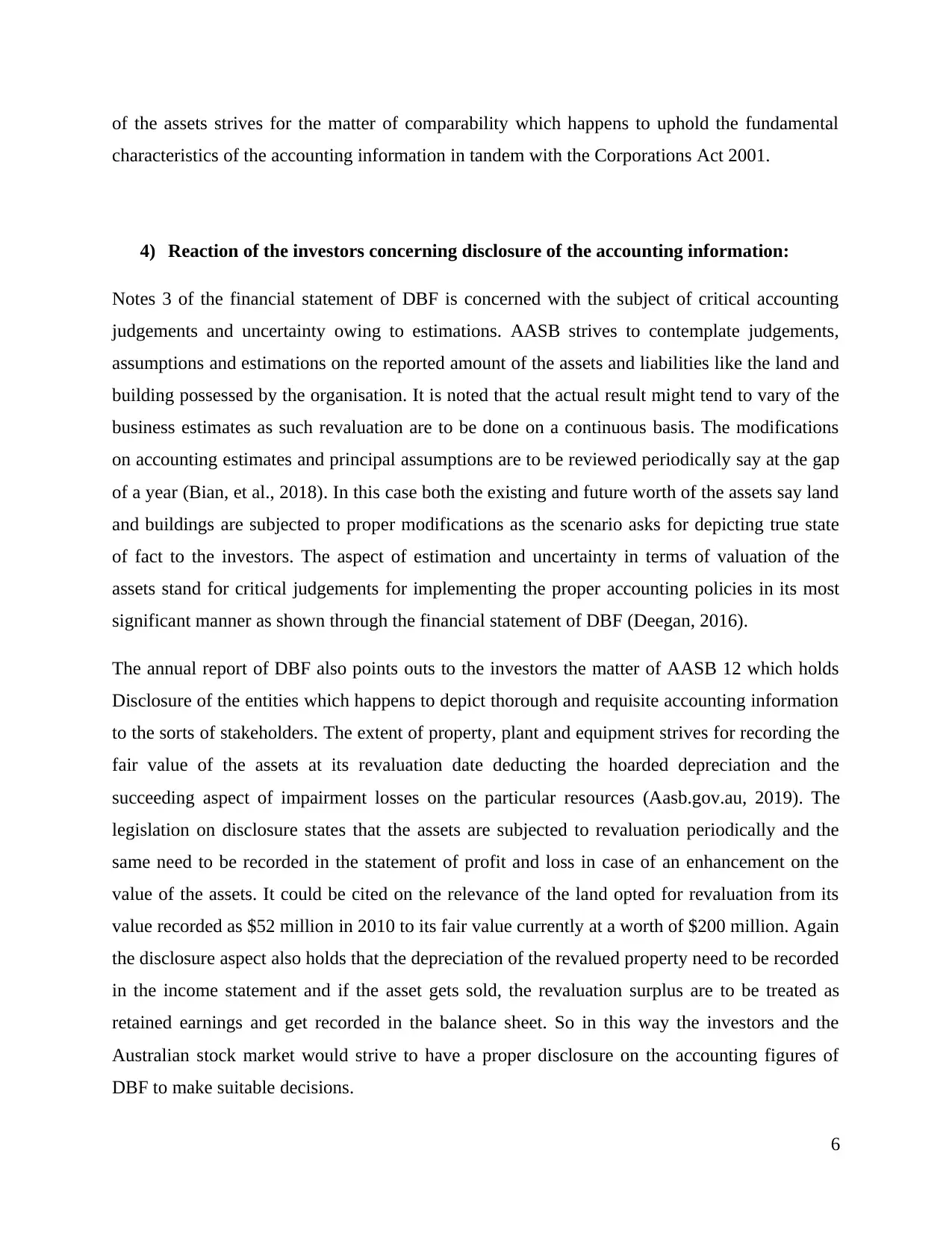
of the assets strives for the matter of comparability which happens to uphold the fundamental
characteristics of the accounting information in tandem with the Corporations Act 2001.
4) Reaction of the investors concerning disclosure of the accounting information:
Notes 3 of the financial statement of DBF is concerned with the subject of critical accounting
judgements and uncertainty owing to estimations. AASB strives to contemplate judgements,
assumptions and estimations on the reported amount of the assets and liabilities like the land and
building possessed by the organisation. It is noted that the actual result might tend to vary of the
business estimates as such revaluation are to be done on a continuous basis. The modifications
on accounting estimates and principal assumptions are to be reviewed periodically say at the gap
of a year (Bian, et al., 2018). In this case both the existing and future worth of the assets say land
and buildings are subjected to proper modifications as the scenario asks for depicting true state
of fact to the investors. The aspect of estimation and uncertainty in terms of valuation of the
assets stand for critical judgements for implementing the proper accounting policies in its most
significant manner as shown through the financial statement of DBF (Deegan, 2016).
The annual report of DBF also points outs to the investors the matter of AASB 12 which holds
Disclosure of the entities which happens to depict thorough and requisite accounting information
to the sorts of stakeholders. The extent of property, plant and equipment strives for recording the
fair value of the assets at its revaluation date deducting the hoarded depreciation and the
succeeding aspect of impairment losses on the particular resources (Aasb.gov.au, 2019). The
legislation on disclosure states that the assets are subjected to revaluation periodically and the
same need to be recorded in the statement of profit and loss in case of an enhancement on the
value of the assets. It could be cited on the relevance of the land opted for revaluation from its
value recorded as $52 million in 2010 to its fair value currently at a worth of $200 million. Again
the disclosure aspect also holds that the depreciation of the revalued property need to be recorded
in the income statement and if the asset gets sold, the revaluation surplus are to be treated as
retained earnings and get recorded in the balance sheet. So in this way the investors and the
Australian stock market would strive to have a proper disclosure on the accounting figures of
DBF to make suitable decisions.
6
characteristics of the accounting information in tandem with the Corporations Act 2001.
4) Reaction of the investors concerning disclosure of the accounting information:
Notes 3 of the financial statement of DBF is concerned with the subject of critical accounting
judgements and uncertainty owing to estimations. AASB strives to contemplate judgements,
assumptions and estimations on the reported amount of the assets and liabilities like the land and
building possessed by the organisation. It is noted that the actual result might tend to vary of the
business estimates as such revaluation are to be done on a continuous basis. The modifications
on accounting estimates and principal assumptions are to be reviewed periodically say at the gap
of a year (Bian, et al., 2018). In this case both the existing and future worth of the assets say land
and buildings are subjected to proper modifications as the scenario asks for depicting true state
of fact to the investors. The aspect of estimation and uncertainty in terms of valuation of the
assets stand for critical judgements for implementing the proper accounting policies in its most
significant manner as shown through the financial statement of DBF (Deegan, 2016).
The annual report of DBF also points outs to the investors the matter of AASB 12 which holds
Disclosure of the entities which happens to depict thorough and requisite accounting information
to the sorts of stakeholders. The extent of property, plant and equipment strives for recording the
fair value of the assets at its revaluation date deducting the hoarded depreciation and the
succeeding aspect of impairment losses on the particular resources (Aasb.gov.au, 2019). The
legislation on disclosure states that the assets are subjected to revaluation periodically and the
same need to be recorded in the statement of profit and loss in case of an enhancement on the
value of the assets. It could be cited on the relevance of the land opted for revaluation from its
value recorded as $52 million in 2010 to its fair value currently at a worth of $200 million. Again
the disclosure aspect also holds that the depreciation of the revalued property need to be recorded
in the income statement and if the asset gets sold, the revaluation surplus are to be treated as
retained earnings and get recorded in the balance sheet. So in this way the investors and the
Australian stock market would strive to have a proper disclosure on the accounting figures of
DBF to make suitable decisions.
6
⊘ This is a preview!⊘
Do you want full access?
Subscribe today to unlock all pages.

Trusted by 1+ million students worldwide
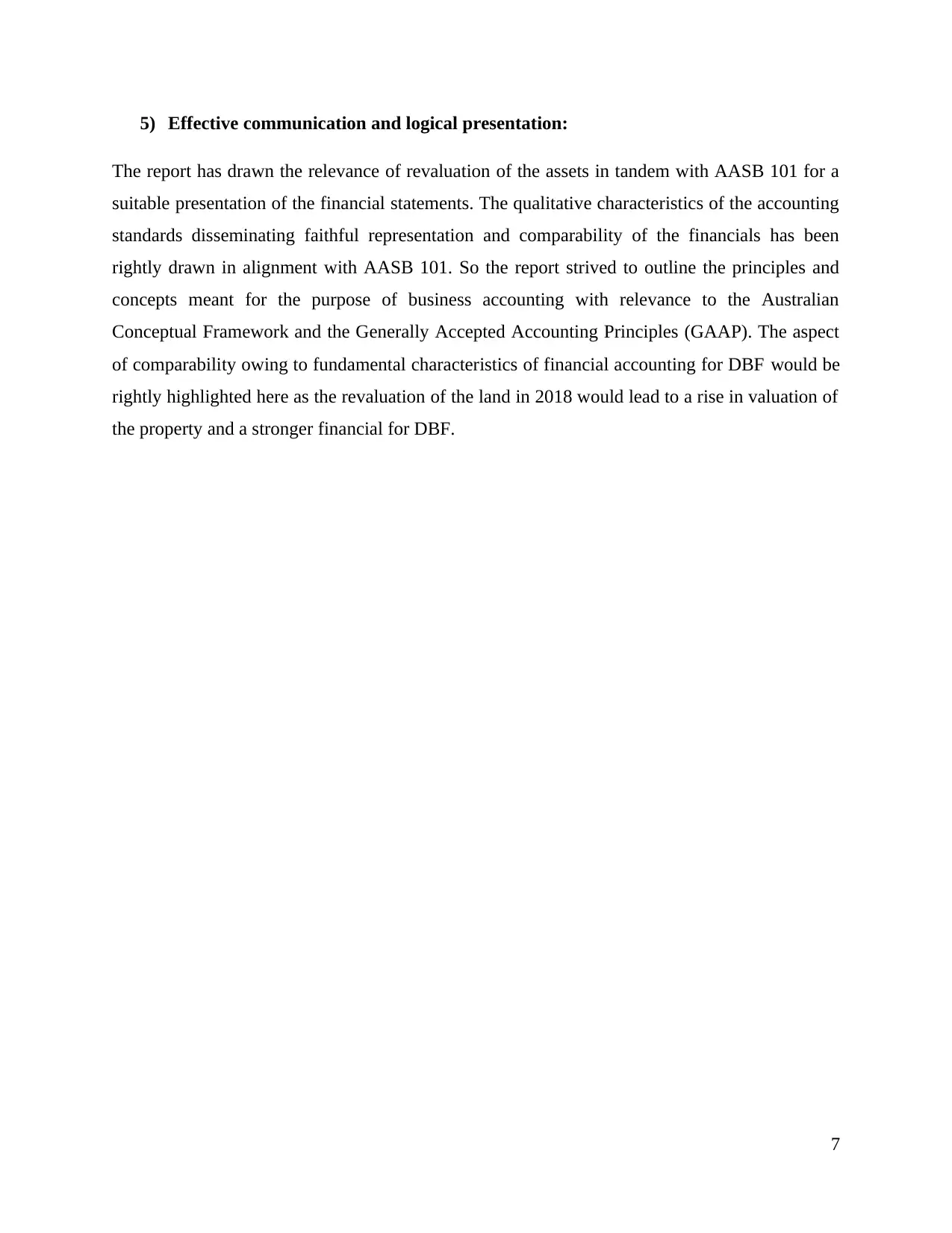
5) Effective communication and logical presentation:
The report has drawn the relevance of revaluation of the assets in tandem with AASB 101 for a
suitable presentation of the financial statements. The qualitative characteristics of the accounting
standards disseminating faithful representation and comparability of the financials has been
rightly drawn in alignment with AASB 101. So the report strived to outline the principles and
concepts meant for the purpose of business accounting with relevance to the Australian
Conceptual Framework and the Generally Accepted Accounting Principles (GAAP). The aspect
of comparability owing to fundamental characteristics of financial accounting for DBF would be
rightly highlighted here as the revaluation of the land in 2018 would lead to a rise in valuation of
the property and a stronger financial for DBF.
7
The report has drawn the relevance of revaluation of the assets in tandem with AASB 101 for a
suitable presentation of the financial statements. The qualitative characteristics of the accounting
standards disseminating faithful representation and comparability of the financials has been
rightly drawn in alignment with AASB 101. So the report strived to outline the principles and
concepts meant for the purpose of business accounting with relevance to the Australian
Conceptual Framework and the Generally Accepted Accounting Principles (GAAP). The aspect
of comparability owing to fundamental characteristics of financial accounting for DBF would be
rightly highlighted here as the revaluation of the land in 2018 would lead to a rise in valuation of
the property and a stronger financial for DBF.
7
Paraphrase This Document
Need a fresh take? Get an instant paraphrase of this document with our AI Paraphraser
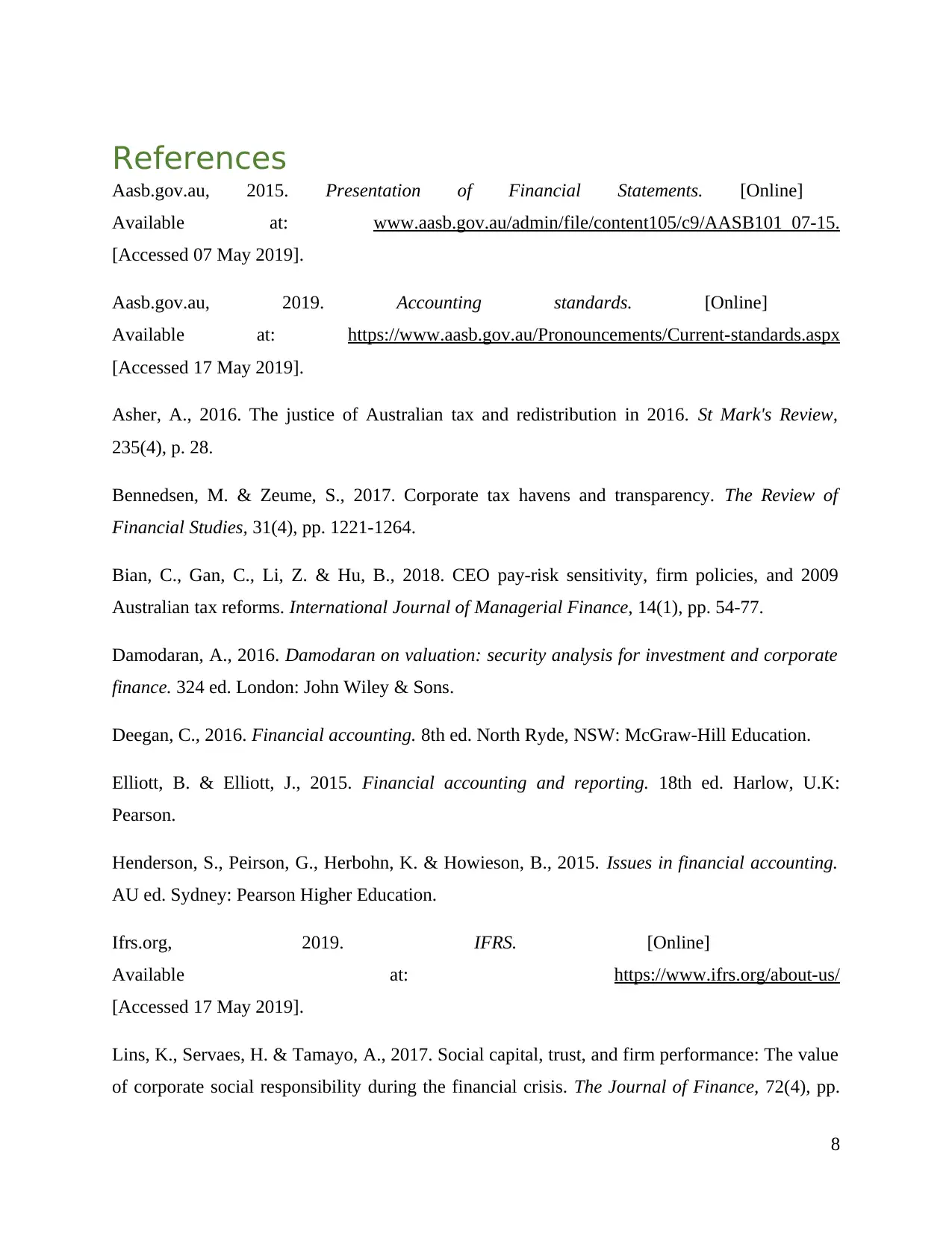
References
Aasb.gov.au, 2015. Presentation of Financial Statements. [Online]
Available at: www.aasb.gov.au/admin/file/content105/c9/AASB101_07-15.
[Accessed 07 May 2019].
Aasb.gov.au, 2019. Accounting standards. [Online]
Available at: https://www.aasb.gov.au/Pronouncements/Current-standards.aspx
[Accessed 17 May 2019].
Asher, A., 2016. The justice of Australian tax and redistribution in 2016. St Mark's Review,
235(4), p. 28.
Bennedsen, M. & Zeume, S., 2017. Corporate tax havens and transparency. The Review of
Financial Studies, 31(4), pp. 1221-1264.
Bian, C., Gan, C., Li, Z. & Hu, B., 2018. CEO pay-risk sensitivity, firm policies, and 2009
Australian tax reforms. International Journal of Managerial Finance, 14(1), pp. 54-77.
Damodaran, A., 2016. Damodaran on valuation: security analysis for investment and corporate
finance. 324 ed. London: John Wiley & Sons.
Deegan, C., 2016. Financial accounting. 8th ed. North Ryde, NSW: McGraw-Hill Education.
Elliott, B. & Elliott, J., 2015. Financial accounting and reporting. 18th ed. Harlow, U.K:
Pearson.
Henderson, S., Peirson, G., Herbohn, K. & Howieson, B., 2015. Issues in financial accounting.
AU ed. Sydney: Pearson Higher Education.
Ifrs.org, 2019. IFRS. [Online]
Available at: https://www.ifrs.org/about-us/
[Accessed 17 May 2019].
Lins, K., Servaes, H. & Tamayo, A., 2017. Social capital, trust, and firm performance: The value
of corporate social responsibility during the financial crisis. The Journal of Finance, 72(4), pp.
8
Aasb.gov.au, 2015. Presentation of Financial Statements. [Online]
Available at: www.aasb.gov.au/admin/file/content105/c9/AASB101_07-15.
[Accessed 07 May 2019].
Aasb.gov.au, 2019. Accounting standards. [Online]
Available at: https://www.aasb.gov.au/Pronouncements/Current-standards.aspx
[Accessed 17 May 2019].
Asher, A., 2016. The justice of Australian tax and redistribution in 2016. St Mark's Review,
235(4), p. 28.
Bennedsen, M. & Zeume, S., 2017. Corporate tax havens and transparency. The Review of
Financial Studies, 31(4), pp. 1221-1264.
Bian, C., Gan, C., Li, Z. & Hu, B., 2018. CEO pay-risk sensitivity, firm policies, and 2009
Australian tax reforms. International Journal of Managerial Finance, 14(1), pp. 54-77.
Damodaran, A., 2016. Damodaran on valuation: security analysis for investment and corporate
finance. 324 ed. London: John Wiley & Sons.
Deegan, C., 2016. Financial accounting. 8th ed. North Ryde, NSW: McGraw-Hill Education.
Elliott, B. & Elliott, J., 2015. Financial accounting and reporting. 18th ed. Harlow, U.K:
Pearson.
Henderson, S., Peirson, G., Herbohn, K. & Howieson, B., 2015. Issues in financial accounting.
AU ed. Sydney: Pearson Higher Education.
Ifrs.org, 2019. IFRS. [Online]
Available at: https://www.ifrs.org/about-us/
[Accessed 17 May 2019].
Lins, K., Servaes, H. & Tamayo, A., 2017. Social capital, trust, and firm performance: The value
of corporate social responsibility during the financial crisis. The Journal of Finance, 72(4), pp.
8
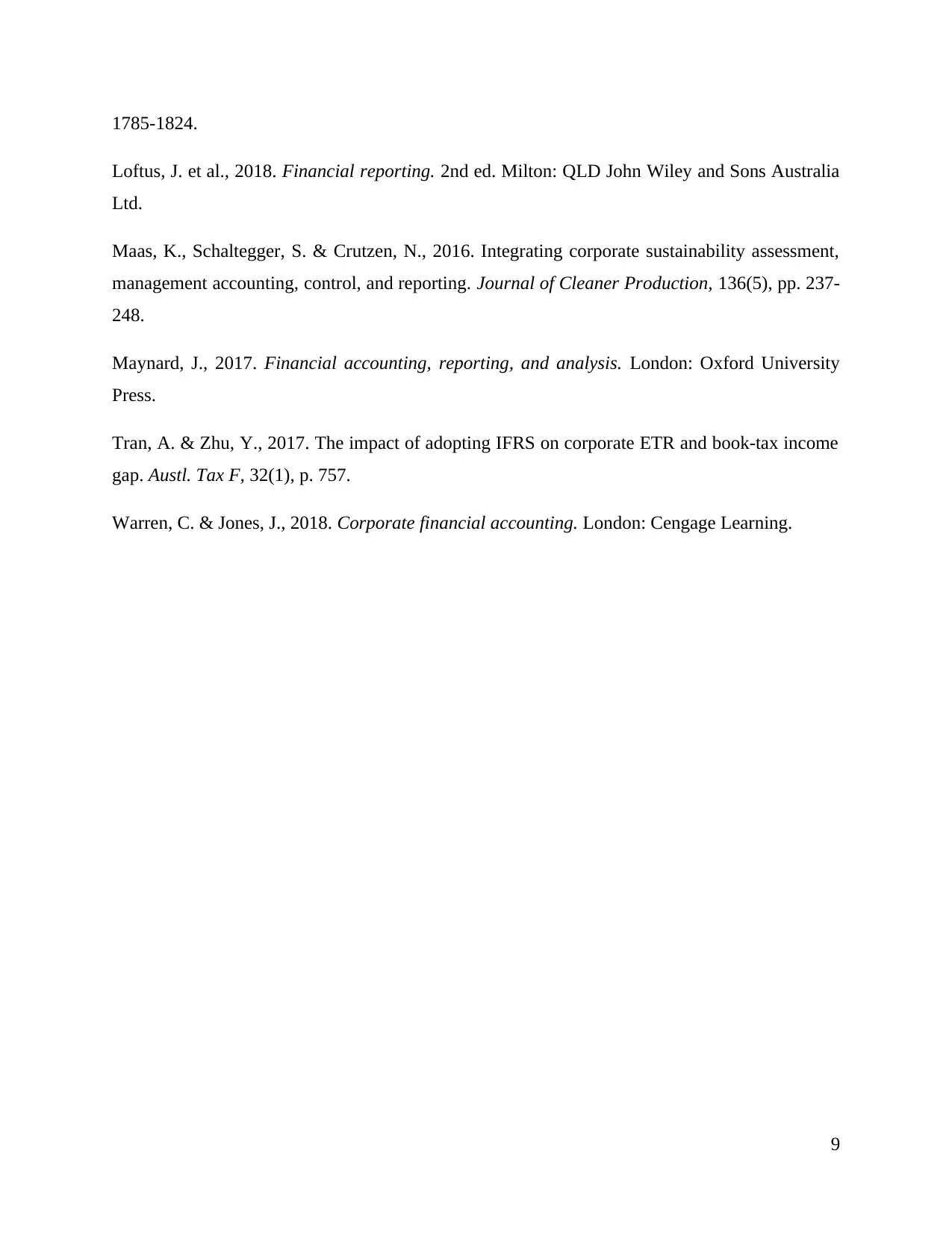
1785-1824.
Loftus, J. et al., 2018. Financial reporting. 2nd ed. Milton: QLD John Wiley and Sons Australia
Ltd.
Maas, K., Schaltegger, S. & Crutzen, N., 2016. Integrating corporate sustainability assessment,
management accounting, control, and reporting. Journal of Cleaner Production, 136(5), pp. 237-
248.
Maynard, J., 2017. Financial accounting, reporting, and analysis. London: Oxford University
Press.
Tran, A. & Zhu, Y., 2017. The impact of adopting IFRS on corporate ETR and book-tax income
gap. Austl. Tax F, 32(1), p. 757.
Warren, C. & Jones, J., 2018. Corporate financial accounting. London: Cengage Learning.
9
Loftus, J. et al., 2018. Financial reporting. 2nd ed. Milton: QLD John Wiley and Sons Australia
Ltd.
Maas, K., Schaltegger, S. & Crutzen, N., 2016. Integrating corporate sustainability assessment,
management accounting, control, and reporting. Journal of Cleaner Production, 136(5), pp. 237-
248.
Maynard, J., 2017. Financial accounting, reporting, and analysis. London: Oxford University
Press.
Tran, A. & Zhu, Y., 2017. The impact of adopting IFRS on corporate ETR and book-tax income
gap. Austl. Tax F, 32(1), p. 757.
Warren, C. & Jones, J., 2018. Corporate financial accounting. London: Cengage Learning.
9
⊘ This is a preview!⊘
Do you want full access?
Subscribe today to unlock all pages.

Trusted by 1+ million students worldwide
1 out of 9
Related Documents
Your All-in-One AI-Powered Toolkit for Academic Success.
+13062052269
info@desklib.com
Available 24*7 on WhatsApp / Email
![[object Object]](/_next/static/media/star-bottom.7253800d.svg)
Unlock your academic potential
Copyright © 2020–2025 A2Z Services. All Rights Reserved. Developed and managed by ZUCOL.



